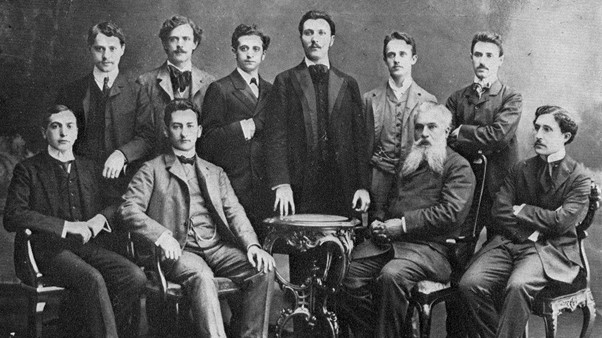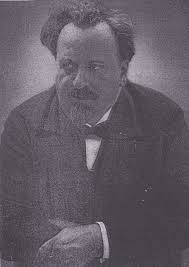Erwin (Peter) Lendvai (4 June 1882, in Budapest – 21 March 1949 in Epsom, Surrey) was a Hungarian composer and choral conductor. And he was an uncle of the composer Kamilló Lendvay (1928-2016).
Born Erwin Loewenfeld in Budapest to Albert Loewenfeld (a lawyer, who died in 1925) and Paula Kozma (a singer from a musical Italian family), Erwin changed (Magyarised) his last name to Lendvai in 1894, when he was twelve years old. He graduated from the Real Gymnasium in 1901 and then continued his education at the conservatory: the National Music Academy of Budapest. There, until about 1905, he studied music, composition, and music theory with Professor Janos (Hans von) Koessler (1853-1926).

Standing: Albert Szirmai, Zoltan Kodaly, Erwin Lendvai, Aladar Szendrey, Karoly Muller, Leo Weiner.
Sitting: Viktor Jacoby, Robert Meszlenyi, Professor Janos (Hans von) Koessler, Sandor Kovacs
In 1905 having won a scholarship to study with Giacomo Puccini in Milan, the great opera composer provided Erwin with recommendations, by way of letters of introduction, for work in Germany. Thus, from 1906 on, Erwin lived in Germany, where he began his teaching career in Berlin.
It was during this period that, in 1906, while attending the opening of Madama Butterfly in Budapest, Giacomo Puccini fell in love with Ervin’s sister, Blanke Lendvai. Blanke and Giacomo Puccini exchanged love letters until 1911.

In 1913 he moved to Hellerau close to Dresden to teach music theory with Emile Jaques-Dalcroze at the Educational Institute for Music and Rhythm. And it was there that he married the photographer Erna Lendvai-Dircksen (1883-1962), famous for her work with the third Reich.
From 1914 to 1920, he returned to Berlin and taught composition at the Klindworth-Scharwenka Conservatory in Berlin and in 1923 took charge of choral singing at the Volksmusikschule in Hamburg. In 1916, Lendvai wrote his one and only opera, Elga (to a libretto by Gerhart Hauptmann).
In the early 1920s Erwin was very active as a choral conductor, spending the years from about 1920 to 1925 working variously in Weimar (1920), Jena (1922), Hamburg (from 1923) and San Remo (1925). In 1924 he separated from – and divorced – Erna Lendvai-Dircksen, after which he worked as a conductor of choral associations in Koblenz, Munich, Saarbrücken and Erfurt. He was also director of a musical society in Koblenz, director of the popular choir of Munich, and in 1929 he premiered Arnold Schoenberg’s choral work Glück Op. 35, No. 4.
Further works by Lendvai include the festival music Völkerfreiheit (1930), a symphony, Archaic dances, Scherzo for orchestra, 3 Pieces for organ Op. 4, chamber music, choral works and songs. Lendvai’s choral music influenced many other choral composers. Sheet Music Download.

As a Jewish composer in National Socialist (Nazi) Germany, threatened with persecution and a ban on his profession – the Nazis banned performances of his work – he emigrated in 1933, first to the Saar region, which was under the jurisdiction of the League of Nations, then to Switzerland after the referendum of 1935 on the annexation of the Saarland. In the fast-changing political situation of 1930s continental Europe, Erwin’s emigration took him via Paris and Switzerland (1935), to Yugoslavia, Hungary, Poland, and Sweden.
Finally, Erwin made his way to England in 1938. There he led a secluded life as a music teacher under the pseudonym “Professor Devinal” (an anagram of his last name, ‘Lendvai’) in Kenninghall, Norwich.
In 1949 Erwin was admitted to West Park Hospital in Epsom, Surrey, but his diagnosis on admission and exact cause of death (one biographer maintaining that he died of a stroke) remains unknown.
Erwin is buried in plot 1531c at Horton Cemetery on the 26th March 1949.

The musicologist Hubert Kolland has noted that Erwin Lendvai’s, ‘…activities were primarily aimed at musical education for the people,’ and that his legacy includes over 450 choral compositions of all genres.
On reading about Erwin, the impression one gets is of a highly cultured, talented, gifted, and influential composer. But, a troubled person too. The ultimate cause of his demise may be unknown, though the combined effects of an unhappy marriage to Erna Lendvai-Dircksen, a trace of a second later marriage to Margit Stapelfeld, and being chased around the European continent before eventually coming to rest in Britain, hint at the possible sources of Erwin’s distress; one critic’s poignant observation underlines his troubles when she records that, ‘In England, Erwin Lendvai became one of the lost migrants…. A [socialist leaning] Jew, ejected from his homeland, who in old age cracks under his disconsolateness.’
A link to Gisene Schroder’s article about Lendvai, from 2013, is given here: The Decline of Men’s Choir. Lendvai | Gesine Schröder – Academia.edu



